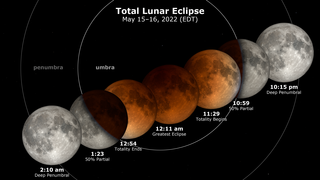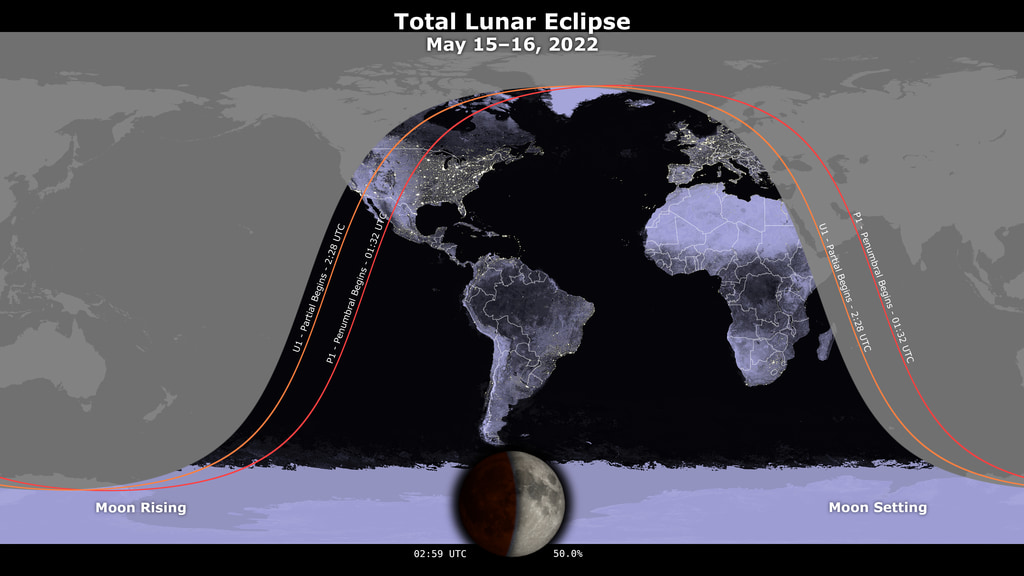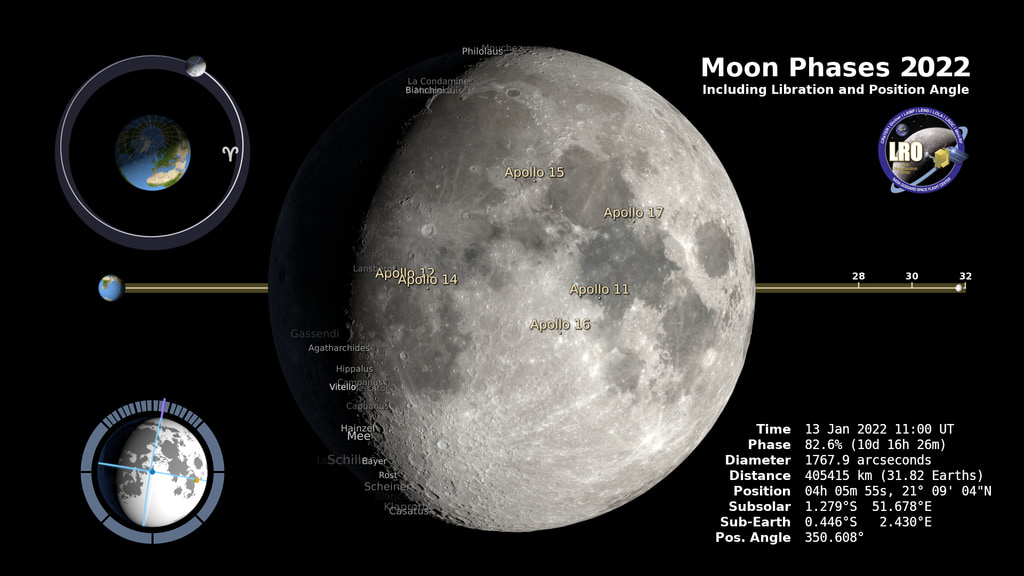May 15-16, 2022 Total Lunar Eclipse: Telescopic View
Dial-A-Moon
Enter a time to see what the moon looked like (or will look like) at that time.
| Time (UTC) | 2023-01-01T00:00 |
|---|---|
| Phase | 00.0% (0d 0h 0m) |
| Diameter | 0000.0 arcseconds |
| Distance | 00.0 km (0.00 Earth diameters) |
| J2000 Right Ascension, Declination | 0h 0m 0s, 0° 0' 0" |
| Sub-Solar Longitude, Latitude | 0.000°, 0.000° |
| Sub-Earth Longitude, Latitude | 0.000°, 0.000° |
| Position Angle | 0.000° |
Also see the shadow diagram and visibility map for this eclipse.
The total lunar eclipse of May 16, 2022 (the night of May 15 in the Western Hemisphere) occurs near perigee, making the Moon appear about 7% larger than average. This eclipse is ideally timed for viewing from most of the Western Hemisphere, including the Lower 48 of the United States. The total phase occurs near moonset in Africa and western Europe.
The sublunar point, the last line of the table above, is the point on the Earth's surface where the Moon is directly overhead. It's also the center of the hemisphere of the Earth where the eclipse is visible. The closer you are to that location, the higher the Moon will be in your sky. The eclipse percentage in the table is the fraction of the Moon covered by the Earth's umbra, the part of its shadow in which the Sun is completely blocked. The part of the shadow in which the Sun is only partially blocked is called the penumbra.
The animations on this page run from 1:00:00 to 7:29:50 UTC, which is also the valid range of times for this Dial-a-Moon. The exposure setting of the virtual camera changes around totality in order to capture the wide dynamic range of the eclipse. The parts of the Moon outside the umbra during the partial phases are almost as bright as an ordinary full moon, making the obstructed parts appear nearly black. But during totality, our eyes adjust and reveal a range of hues painted on the Moon by all of Earth's sunrises and sunsets.
All phases of a lunar eclipse are safe to view, both with your naked eye and an unfiltered telescope.
The appearance of the Moon during the May 2022 total lunar eclipse. Includes annotations of the contact times and various eclipse statistics.
The appearance of the Moon during the May 2022 total lunar eclipse. The EXR frames are the original rendered images, while the TIFFs combine these into a single image sequence. Both include an alpha channel.
Credits
Please give credit for this item to:
NASA's Scientific Visualization Studio
-
Visualizer
- Ernie Wright (USRA)
-
Producer
- David Ladd (USRA)
-
Scientist
- Noah Petro (NASA/GSFC)
-
Technical support
- Laurence Schuler (ADNET Systems, Inc.)
- Ian Jones (ADNET Systems, Inc.)
Release date
This page was originally published on Thursday, March 24, 2022.
This page was last updated on Monday, July 15, 2024 at 12:09 AM EDT.
Missions
This visualization is related to the following missions:Series
This visualization can be found in the following series:Datasets used in this visualization
-
DEM (Digital Elevation Map) [LRO: LOLA]
ID: 653 -
DE421 (JPL DE421)
ID: 752Planetary ephemerides
This dataset can be found at: http://ssd.jpl.nasa.gov/?ephemerides#planets
See all pages that use this dataset -
LROC WAC Color Mosaic (Natural Color Hapke Normalized WAC Mosaic) [Lunar Reconnaissance Orbiter: LRO Camera]
ID: 1015This natural-color global mosaic is based on the 'Hapke normalized' mosaic from LRO's wide-angle camera. The data has been gamma corrected, white balanced, and range adjusted to more closely match human vision.
See all pages that use this dataset
Note: While we identify the data sets used in these visualizations, we do not store any further details, nor the data sets themselves on our site.




